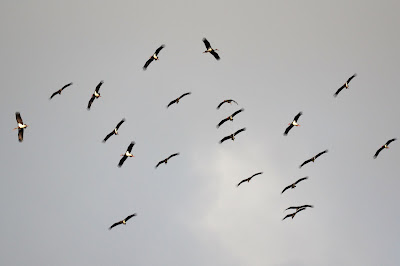 I had a short break before Christmas, and what better to do than go to the Tarifa area, as so many times before. I stayed at the Hotel Dos Mares, also as many times before. The view from the front line bungalows there are simply stunning.
I had a short break before Christmas, and what better to do than go to the Tarifa area, as so many times before. I stayed at the Hotel Dos Mares, also as many times before. The view from the front line bungalows there are simply stunning.On Sunday the 10th, I had agreed with Yeray Seminario at Birding the strait to have a half day at La Janda to look for Spanish Imperial Eagle. And it was a success. We had at least three individuals, 2 adults and 1 immature. At the site for one of the adults, we also constantly had an immature Bonneli's Eagle in view. We also had three Black Storks, four Spoonbills, three Black-winged Kites, two Hen Harriers and some Red Kites. In La Janda, also about 500 Cranes, 300 Golden Plovers and quite a lot of other waders were wintering. In the evening, I walked along Los Lances, and had a nice flock of 17 Audouins Gulls.
On Monday, it was quite stormy with rain, so I did some property search in stead. I managed a short visit to Palmones estuary, though. 1 Mediterranean Gull was the most interesting. On Tuesday, it had cleared up and I went up along the Costa de la Luz. First, I visited Barbate. There I had about 20 Stone Curlews and about 10 Bald Ibises. It is not far from the breeding
 site at Barca de la Vejer, so this is natural.I then drove up to Chipiona to look for Little Swifts, which in fact winter there. I had none, but a Caspian Tern and a Booted Eagle was ok. Next stop was the Bonanza Saltpans. Due to the rain the day before, I did not drive far into the area, but I drove enough to have Slender-billed Gulls and Flamingoes. Next stop was Laguna Tarelo. This is a very accessible and rewarding small lake, good in spring, autumn and winter. This time I saw Black-necked Grebe, 10 Shovelers, 15 White-headed Ducks, 40 Black-crowned Night Herons and one Little Swift.
site at Barca de la Vejer, so this is natural.I then drove up to Chipiona to look for Little Swifts, which in fact winter there. I had none, but a Caspian Tern and a Booted Eagle was ok. Next stop was the Bonanza Saltpans. Due to the rain the day before, I did not drive far into the area, but I drove enough to have Slender-billed Gulls and Flamingoes. Next stop was Laguna Tarelo. This is a very accessible and rewarding small lake, good in spring, autumn and winter. This time I saw Black-necked Grebe, 10 Shovelers, 15 White-headed Ducks, 40 Black-crowned Night Herons and one Little Swift.By the way, when driving up to Chipona, I chose to go through El Puerto de Santa Maria. And there, in the middle of the round-about, with Burger King as the nearest neighbour- a replica of La Nina... what a place for this historic and world-famous Columbus ship!
On the way back, I encountered a circling flock of about 150 White Storks between Tarifa and La Janda. It might in fact have been the first arriving flock on "spring migration" as many leave Spain already in July and will start to return already in January- so why not December...?
Last day was a real mess, as I found out that I had a return ticket for 13th of February and not December..., so the best thing to do was to go to Malaga to sort things out.
More photos here: https://photos.app.goo.gl/QX4NkaXn0jJHaOTi2









